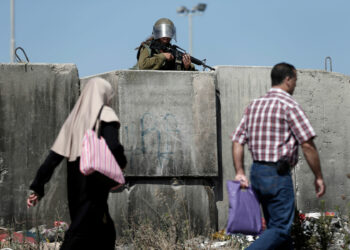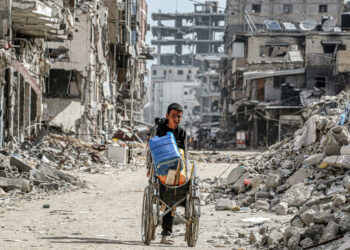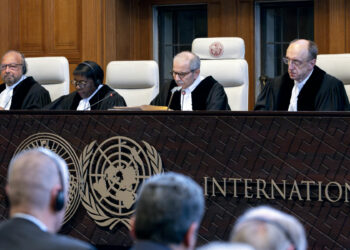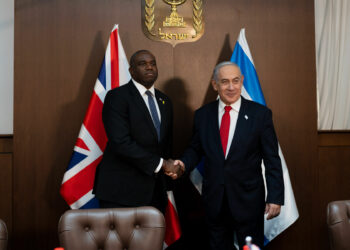Kaveh Madani is a Research Professor at the City College of New York and a former deputy head of Iran’s Department of Environment.
عربي
Iran is out of water, and Iranians are fed up. Over the past year, they have steadily taken to the streets to show their frustration over severe water shortages and the government incompetence exacerbating them. The latest epicenter for this outrage was the central city of Isfahan, once the capital of the Safavid Empire and the home to Zayandeh Rud, one of Iran's most famous rivers and the source of livelihood for hundreds of thousands of farmers. But it has been running dry for years now. Literally translated as "life giver," Zayandeh Rud became the battlefield for bloody protests in November, when thousands of farmers, environmental activists and concerned citizens camped out on a long strip of the dried-out riverbed that symbolizes the tragic fate of their national treasure.
The Isfahan protests came hard on the heels of deadly demonstrations over water shortages in Khuzestan province, in southwest Iran, during the summer of 2021. The residents of resource-rich Khuzestan, including its ethnic Arab population, expressed anger over the government's gross mismanagement of water and destruction of the province's natural environment, sacrificed in pursuit of decades of oil and gas extraction. Like Isfahan, Khuzestan is yet another example of Iran's current state of "water bankruptcy." The country uses more water each year than it replenishes. There is simply not enough water left to satisfy the basic needs of farmers, rural inhabitants, water-inefficient industries and Iran's thirsty wetlands.
Given their large scale and anti-government sentiment, these latest water protests in Iran have grabbed global headlines. But all that media coverage fails to paint a full picture of the magnitude of environmental devastation in the country. Drying rivers, vanishing lakes, decreasing levels of groundwater, sinking land, dangerous dust storms, water pollution, deforestation, loss of biodiversity and wildfires are just a few of the warning signs that have been ignored by the government, causing irreversible damage to Iran's ecosystem.
Water bankruptcy in Iran has been a predictable and inevitable outcome. If water resources are thought of as money—for example, surface water and groundwater as checking and saving accounts—the Iranian government has drained all of its finances and left customers with the equivalent of bounced checks. The protests that unfolded in Isfahan and Khuzestan are clear manifestations of water bankruptcy, where the water claimants, in this case farmers, were like depositors standing outside an empty bank.
The violent conflicts over the lack of water in Iran in recent months are the result of environmental injustice and a lack of foresight by the Iranian government.
- Kaveh Madani and Sanam Mahoozi
Since the Islamic Revolution in 1979, the Iranian government has been possessed by the mentality of self-sufficiently and stated independence from the outside world, partly in response to years of strict economic sanctions and war, and partly because of the desire to project regional influence. Quenching this "thirst for development" has been to the detriment of Iran's precious water resources, which have been depleted for decades by unsustainable development.
One of the most revealing examples of this narrow ideological campaign is the government's cultivation of a staggeringly inefficient agriculture sector that relies heavily on irrigation and receives more than 90 percent of Iran's allocated freshwater resources. The government has tried to support farmers by subsidizing agricultural water and energy use, allowing them to wastefully use these resources to achieve some level of food security while keeping the rural population employed. Worsening this trend, the government for years has mishandled water allocation through excessive construction of dams and water transfer tunnels that move water from one river basin to another, to offset water shortages in different parts of Iran. But that is causing problems for both water-rich areas, such as Khuzestan, and for water-poor ones, such as Isfahan.
The violent conflicts over the lack of water in Iran in recent months are the result of this environmental injustice and lack of foresight by the Iranian government. The authorities failed to implement policies that would go a long way toward permanently curing the problem of water shortages—through advanced technologies and water conservation, modernization of the agricultural sector, reduction of water and energy subsidies, and providing alternative means of livelihood to rural populations. Instead, the government has always resorted to temporary fixes, such as transferring more water from other river basins, digging deeper wells, or even organizing large prayer events for rain.
Despite its severity, the current drought in Iran comes against the backdrop of two extremely wet years in rainfall that helped fill many reservoirs across the country and provided some relief to farmlands. But this, of course, didn't last long, since the water in those reservoirs quickly vanished, given the government's lack of readiness and planning for dry conditions and rising temperatures. Although only a catalyst to Iran's current water miseries, climate change is expected to intensify and accelerate extreme events such as droughts, wildfires and dust storms, making the environmental situation worse than it already is under Iran's authorities today.
As in Iran, Syria's chronic water shortages were the result of decades of government mismanagement, along with population disruptions that were compounded by climate change.
- Kaveh Madani and Sanam Mahoozi
Water insecurity in Iran risks social unrest, given that water bankruptcy could result in widespread unemployment and poverty for farmers and other rural populations. Consider what happened in Syria before its civil war. From 2006 to 2010, Syria suffered from a severe drought that turned famously areas of the Fertile Crescent— the birthplace of farming more than 10,000 years ago—into desert. Two to three million Syrians were pushed into severe poverty, and many farmers lost their livelihoods entirely. That collapse of farming, especially in northeastern Syria, led to the mass migration of around 1.5 million people to Syrian cities, straining life in those urban areas and putting huge pressure on the country's inadequate water and electricity resources. As in Iran, Syria's chronic water shortages were the result of decades of government mismanagement by the Ba'ath Party regime under Hafez al-Assad and then his son, Bashar, along with population disruptions that were compounded by the long-term trend of less rainfall and higher temperatures brought on by climate change.
What is unfolding in Iran today over its water shortages, and what has already happened in Syria, should serve as an eyeopener for other countries in the Middle East that suffer from similar problems of unsustainable development, poor environmental governance, and an overreliance on water in their economic sector. Governments must look at water bankruptcy through the lens of political economy and realize that without decoupling the regional economy from water, the Middle East's regional stability is seriously in danger. Using non-renewable water resources to keep populations precariously employed is risky business for Middle Eastern governments. Water is intrinsically linked to national security, especially wherever low-income populations in rural areas depend heavily on water for their jobs and for feeding their families. Decoupling the economy from water is unachievable without economic diversification and a sustainable growth of the service and industrial sectors to provide new employment opportunities and means of livelihood to farmers and rural populations.
Unless this reality sinks in and governments make profound reforms to these faulty water practices, more conflicts over water shortages will erupt as the region gets even hotter and drier, with global consequences.







